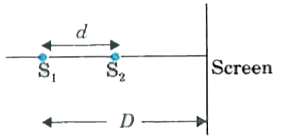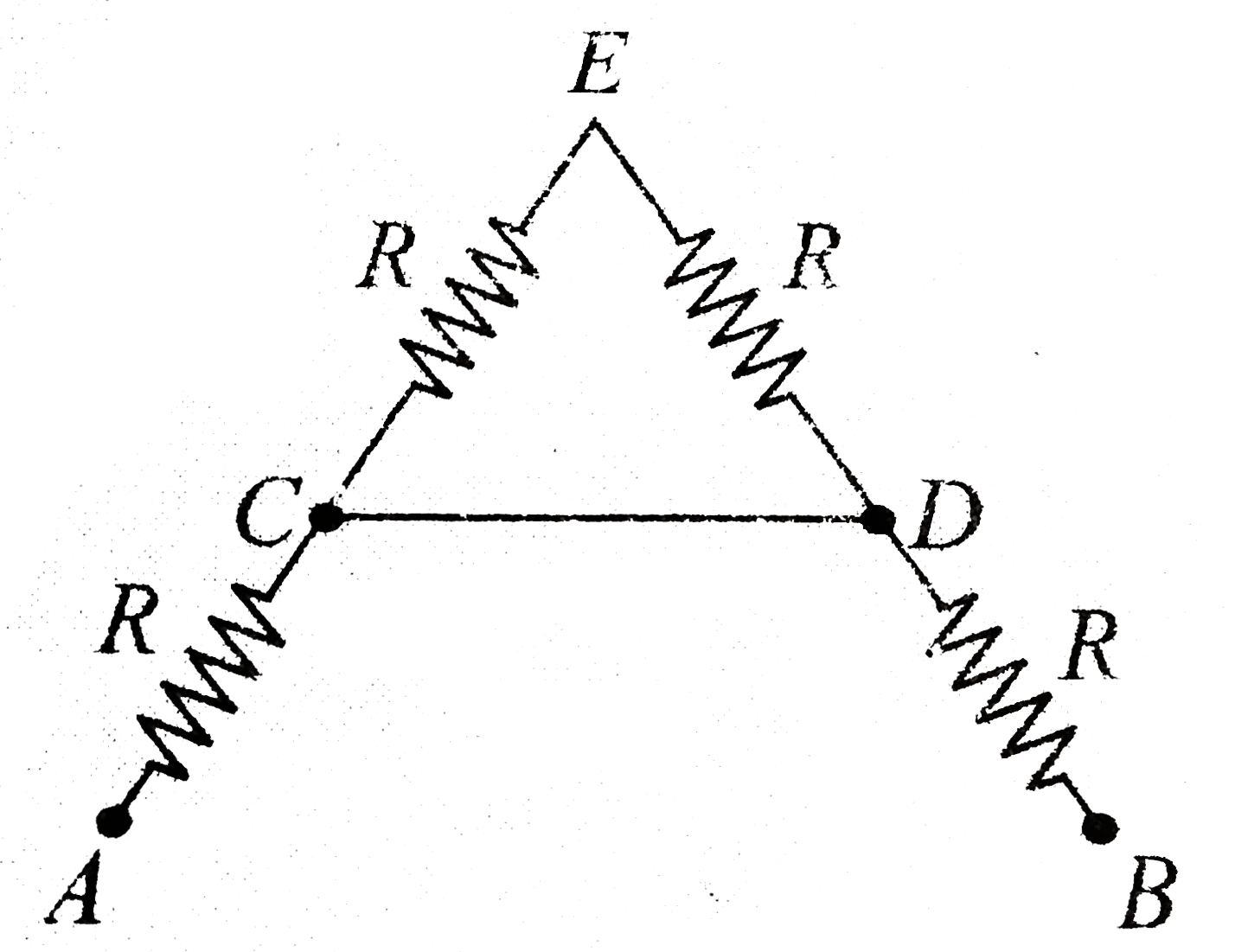Four identical monochromatic source A, B, C, D as shown in figure produce waves of the same wavelength λ and are coherent. Two receivers R1 and R2 are at great but equal distance from B. The choose the correct statements.

In Fig. A, B, C, D are four idential monochromatic coherent sources producing waves of same wavelength λ.
AB=BC=BD=λ/2.
R1 and R2 are two receivers held as shown such that R1B=R2B=d(>>λ).
Let the wave at R1 from BandA=λ/2 so that phase diff. is π.
∴ The wave at R1 because of source B is
yB=acos(ωt−π)=−acosωt
Similarly, path diff. of singal at R1 from C and A =λ so that phase diff. =2π
∴ The wave at R1 because of source C is
yC=acos(ωt−2π)=acosωt
Again, path diff. of signal at R1 From D that of A is
=√d2+(λ2)2−d(d−λ/2)=d(1+λ24d2)1/2−d+λ2=d(1+λ28d2)−d+λ2≅λ2 (∵d>>λ)
Therefore, phase diff. is π
yD=acos(ωt−π)=−acosωt
Hence the signal picked up at R1 from all the four sources is
yR1=yA+yB+yC+yD=acosωt−acosωt+acosωt−acosωt=0. ...(i)
Let the the signal picked up at R2 from to be yB=a1cosωt
Path differecne of signals at R2 from D to that from B is λ/2. Therefore, yD=a1cos(ωt−π)
=−a1cosωt.
Again, path diff. of signals at R2 from B and A is
=√d2+(λ/2)2−d=d(1+λ24d2)1/2−d=18λ2d2
As d>>λ, therefore this path diff. →0, and phase diff. ϕ→0∴yA=a1cos(ωt−ϕ)
Similarly, yC=a1cos(ωt−ϕ)
Hence the signal picked up at R2 from all the four sources is
yR2=yA+yB+yC+yD=a1cos(ωt−ϕ)+a1cosωt+a1cos(ωt−ϕ)−a1cosωt
yR2=2a1cos(ωt−ϕ) ...(ii)
Hence receiver R2 picks up the larger signal.
(ii) If source B is swithched off, then from (i),
yR1=acosωt<IR1>=a2<cos2ωt>=a22
From (ii), yR2=a1cos(ωt−ϕ)=a1cosωt,∵ϕ→0<IR2>=a21<cos2ωt>=a212=a22.
Hence R1 and R2 pick up the same signal.
(iii) When source D is swithched off, YR1=acosωt
∴<IR1>=a22 and yR2=3acosωt (Taking ϕ→0)
<IR2>=9a2<cos2ωt>=92a2 ∴R2 picks up larger signal compared to R1.
(iv) Hence a signal at R1 indicates that source B has been switched off and an anhanced signal at R2 indicates that source D has been switched off.

Topper's Solved these Questions
- OPTICSBook:PRADEEPChapter:OPTICSExercise:Very short answer question
Explore 5 Videos
- OPTICSBook:PRADEEPChapter:OPTICSExercise:very short answer questions
Explore 1 Video
- MAGNETIC EFFECT OF CURRENT AND MAGNETISMBook:PRADEEPChapter:MAGNETIC EFFECT OF CURRENT AND MAGNETISMExercise:Competition Focus (Multiple Choice Questions)
Explore 2 Videos
Similar Questions
Four identical monochromatic sources A,B,C,D as shown in the (figure) produce waves of the same wavelength λ and are coherent. Two receiver R1 and R2 are at great but equal distances from B.
(i) Which of the two receivers picks up the larger signal when B is turned off?
(iii) Which of the two receivers picks up the larger singnal when D is turned off ?
(iv) Which of the two receivers can distinguish which of the sources B or D has been turned off ?

View SolutionA source S and a detector D are placed at a distance d apart. A big cardboard is placed at a distance √2d from the source and the detector as shown in figure. The source emits a wave of wavelength =d2 which is received by the detector after reflection from the cardboard. It is found to be in phase with the direct wave received from the source. By what minimum distance should the cardboard be shifted away so that the reflected wave becomes out of phase with the direct wave ?

View Solution
Knowledge Check
Four identical coherent sourc e emiting monochromatic light if same wavelength lambda are placed at A,B,C and D as shown. Two receivers R1 and R2 are at but equal distance from B. The path difference between signals reaching from A&D at R1 is λ2 and between signals reaching from A & B at R2is≅0. Also assume that intensities of waves emitted by A,B,C &D reaching at R1 and R2 is same.
 AR1records greater intensity if all the sources are on.BR1andR2 records same intensity if B is switched of, and other sources are on.CR2 records greater intensityif D switched off, and other sources are on.DIt is possible to know, whether B is switch off or D is switched off by recording intensities at R1 and R2
AR1records greater intensity if all the sources are on.BR1andR2 records same intensity if B is switched of, and other sources are on.CR2 records greater intensityif D switched off, and other sources are on.DIt is possible to know, whether B is switch off or D is switched off by recording intensities at R1 and R2Two coherent point sources S1 and S2 are separated by a small distance d as shown. The fringes obtained on the screen will be
 ApointsBstraight linesCsemi-circlesDconcentric circles
ApointsBstraight linesCsemi-circlesDconcentric circlesTwo coherent point sources S1andS2 are separated by a small distance 'd' as shown. The fringes obtained on the screen will be :
 Astraigth linesBsemi-circleCconcentric circlesDpoints
Astraigth linesBsemi-circleCconcentric circlesDpoints
A source S and a detector D are placed at a distance d apart. A big cardboard is placed at a distance √2d from the source and the detector as shown in figure. The source emits a wave of wavelength =d/2 which is received by the detector after reflection from the cardboard. It is found to be in phase with the direct wave received from the source. By what minimum distance should the cardboard be shifted away so that the reflected wave becomes out of phase with the direct wave?

View SolutionSome energy levels of a molecule are shown in the figure. The ratio of the wavelengths r=λ1/λ2 is given by -

View SolutionFour identical resistances each having value R are arranged as shown in Figure. Find the equivalent resistance between A and B.

View SolutionTwo identical beam A and B of plane coherent waves of the sasme intensity and wavelength λ fall on a plane screen. The direction of the beam propagations make angles θ1 and θ2 with the normal to the screen and lie in the same plane as shown in the figure. Find the distance β between adject interfrence fringes on the screen.

View SolutionFour cars A,B and C are moving on a levelled road. Their distance versus time graphs are shown in Fig. Choose the correct statement

View Solution